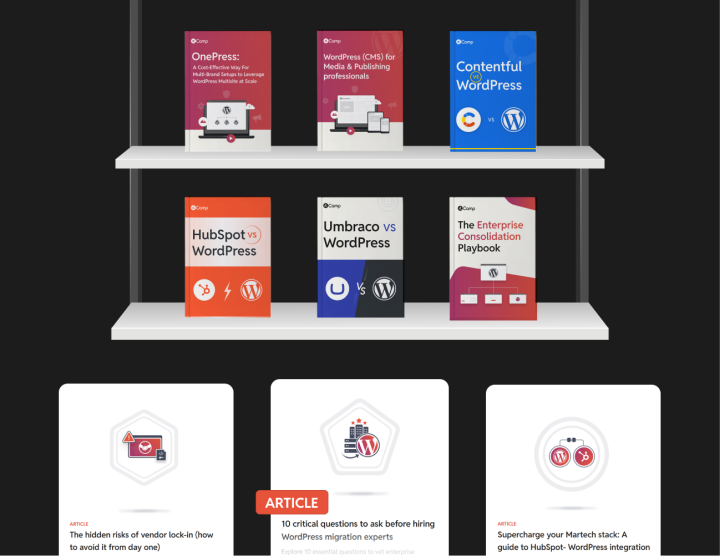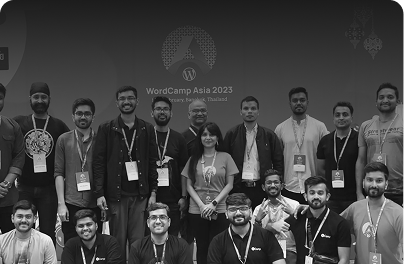Sitecore vs WordPress: An overview
Choosing between Sitecore and WordPress?

Both Sitecore and WordPress are proven CMSs known for delivering content management at scale. Choosing between the two needs careful consideration of their overall alignment with your business goals, their total cost of ownership, and their scalability possibilities, among other factors.
To ensure you have all the information you need to make an informed choice, we’ve put together this comprehensive Sitecore vs WordPress handbook.
In this handbook, you’ll discover:
- Which CMS better aligns with your business goals (both now and in the foreseeable future)
- What the total cost of ownership (TCO) looks like for Sitecore and WordPress over their lifecycle (and which one potentially offers better value)
- How Sitecore and WordPress function as headless CMS platforms (and whether Sitecore’s purely headless solution is actually better and more future-proof than WordPress’s “agile” CMS)
- How WordPress and Sitecore compare in performance and scalability—does Sitecore’s enterprise-grade infrastructure deliver superior performance, or can WordPress scale just as well with the right hosting and implementation?
- How Sitecore and WordPress handle content delivery at scale (and whether Sitecore is truly more efficient for managing complex content, or if WordPress can offer a comparable solution)
- Which CMS can be fully customized to your needs (weighing the benefits and limitations of a fully customizable solution versus a more straightforward, out-of-the-box option with vendor lock-in)
And more.
Comparing Sitecore and WordPress
Here’s a side-by-side comparison snapshot of the key areas, with detailed explanations in the chapters ahead.
| Criteria | Sitecore | WordPress |
| 1. Total Cost of Ownership (TCO) | High. Licensing, implementation, ongoing maintenance, and specialized development resources add significant costs. Sitecore’s composable DXP model often leads to rising costs as additional modules are added. | Cost-effective. Open-source licensing (no fees) and lower development/hosting costs. Managed hosting options like WordPress VIP offer predictable, transparent pricing and significant savings in development and maintenance. |
| 2. Licensing & Initial Setup | Expensive licensing fees, particularly for XM Cloud, the latest version customers are being requested to upgrade to. Implementation requires specialized partners and a niche talent pool. | No licensing fees for the software itself. Lower upfront investment with flexibility to choose from a variety of managed hosting providers. |
| 3. Development & Customization | Limited talent pool and high development costs. Customizing workflows, building integrations, and adding custom functionalities is resource-intensive. | Vast developer ecosystem, ready-to-deploy integrations with enterprise solutions, and wide plugin market ensure cost-effective customization and faster delivery. |
| 4. Maintenance & Upgrades | Complex upgrades (especially for on-premise Sitecore). Upgrades can also feel like full rebuilds. Even with XM Cloud (that comes with managed updates), customizations complicate updates and require vendor-specific expertise. | Managed hosting (e.g., WordPress VIP) offers seamless updates and backward compatibility. Lower technical debt and fewer resources needed to maintain highly customized implementations. |
| 5. Hosting & Infrastructure | Resource-intensive, often coupled with Microsoft Azure. XM Cloud covers backend hosting but requires separate frontend hosting and vendor coordination (as it’s a headless-only CMS solution). | Modular, efficient infrastructure. Managed hosting (VIP, Kinsta, etc.) ensures secure, enterprise-grade performance. Fully vendor-neutral, with flexibility to choose the best providers for each part of your stack. |
| 6. Architecture & Flexibility | Headless-first in XM Cloud (no flexibility to go monolithic). Legacy XM/XP offer more choices but complex to switch between architectures. | Fully flexible: monolithic, headless, or hybrid. Can adapt or switch architectures as business needs evolve, providing futureproof options for growth and agility. |
| 7. Headless Capabilities | XM Cloud is purely headless. Advanced headless support but less flexibility if you later want to pivot. | WordPress is headless-ready via REST API and WPGraphQL. Hybrid implementation possible, ensuring flexibility. |
| 8. Content Creation & Editorial UX | Modern visual editors (Pages) but historically steeper learning curve. Collaboration features are more advanced but require onboarding and IT support. | WordPress’s block editor (Gutenberg) is user-friendly and intuitive, empowering content teams with minimal training. Plugin ecosystem ensures even complex workflows and editorial processes are easy to set up and adapt. |
| 9. Business Alignment & Scalability | Strong for fully unified digital experiences (especially if using full Sitecore DXP suite). However, vendor lock-in can limit flexibility as your business grows or pivots. | Modular, vendor-neutral, and fully integrable with best-of-breed solutions. Scales incrementally without forcing a single-vendor approach. |
| 10. Personalization | Out-of-the-box personalization “lite” in XM Cloud. For full capabilities, requires additional purchase of Sitecore’s Personalize solution, adding to licensing costs. | Basic personalization achievable via plugins. For advanced personalization, integrates easily with third-party solutions (like Adobe Target) without being tied to proprietary tools. |
| 11. Integration Ecosystem | Best suited for a Sitecore-centric DXP stack. Adding third-party integrations can be complex and expensive, with limited vendor options due to licensing constraints. | Integrates easily with thousands of third-party solutions (Salesforce, HubSpot, analytics, personalization). No forced reliance on a single vendor suite, ensuring maximum adaptability. |
| 12. Vendor Lock-in | High vendor lock-in with Sitecore and its modules. Migrating away can be expensive and challenging. | Open ecosystem with broad hosting and implementation choices. Low or no vendor lock-in, enabling you to evolve your tech stack over time with minimal friction. |
| 13. Security | Enterprise-grade security via Sitecore XM Cloud’s managed services. Additionally, security audits and updates often require Sitecore-certified resources, increasing operational overhead. | Enterprise-grade security with managed hosting partners (VIP). Extensive plugin ecosystem for additional security hardening and compliance. Transparent processes due to open-source nature. |
| 14. Talent Availability | Limited pool of Sitecore-certified developers. High recruitment and retention costs. | Massive pool of WordPress developers, agencies, and service providers. Lower hiring and training costs across the board. |
| 15. Support & Community | Official enterprise support from Sitecore but more restricted in scope (certifications required). Community is smaller and more focused on enterprise-only contexts. | Extensive support via managed hosts (VIP, etc.) and massive global community. Thousands of agencies and freelancers offer accessible support. |
| 16. Futureproofing | Strong future if committed to Sitecore’s ecosystem. Switching or re-architecting (e.g., from monolithic to headless) needs complete rebuilds. | Futureproof due to its modular, open architecture powered by an active, engaged community. Easy to evolve with changing business and technology landscapes without costly re-platforming. |
| 17. Migration Costs & Risks | Migration to or from Sitecore is typically expensive, requiring specialized agencies. Historical upgrades have been complex and time-consuming (like re-platforming). | Migration to/from WordPress is simpler and more cost-effective. WordPress is often chosen by enterprises looking to reduce long-term overhead and complexity. |
| 18. ROI & Long-term Financial Impact | High TCO and licensing costs can erode ROI, especially if only using Sitecore for CMS (rather than full DXP). Often better ROI for enterprises already invested in Sitecore’s full experience suite. | Consistent ROI for enterprises seeking a CMS-first or “agile CMS” approach. Cost-effective implementation and easier vendor-neutral integrations. |
| 19. Final Enterprise Fit | Best for enterprises committed to a fully integrated DXP and prepared for vendor lock-in. Ideal for those who prioritize advanced personalization, customer data management, and Sitecore’s composable suite. | Best for enterprises prioritizing flexibility, lower TCO, faster time-to-market, and future-ready digital strategies. Equally effective for monolithic, headless, or hybrid delivery without complexity or high costs. |
About rtCamp :
We’re a WordPress VIP Gold Agency Partner, specializing in building enterprise-grade WordPress implementations. As part of our consultation services (that include up to 20 hours of free scoping), we can help you learn how WordPress can—and if it can—meet all your CMS expectations. Book a free consultation.







